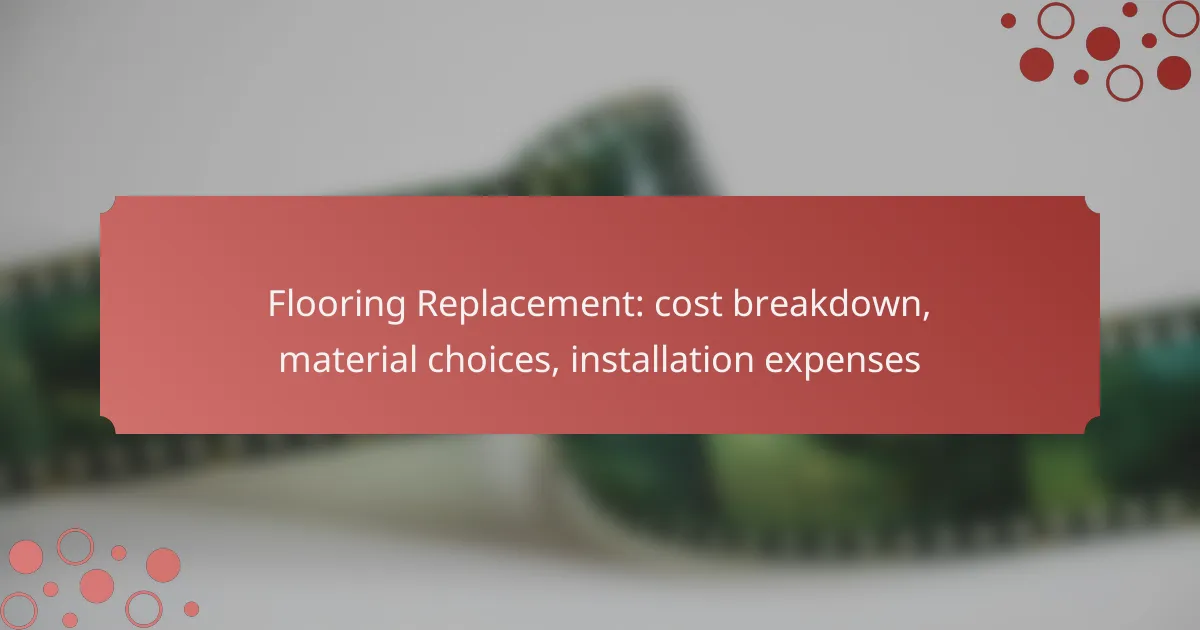Replacing flooring can be a significant investment, with costs influenced by material selection, area size, and installation complexity. Homeowners typically face a price range from a few tens to several hundreds of pounds per square meter. Choosing the right material—such as hardwood, laminate, vinyl, or tile—requires careful consideration of durability, aesthetics, and overall cost. Installation expenses also vary widely based on the chosen material and local labor rates.

What are the flooring replacement costs in the UK?
Flooring replacement costs in the UK can vary significantly based on the type of material chosen, the size of the area, and the complexity of the installation. Generally, homeowners can expect to spend anywhere from a few tens to several hundreds of pounds per square meter, depending on these factors.
Average cost per square meter
The average cost for flooring replacement in the UK typically ranges from £20 to £100 per square meter. For example, laminate flooring may cost around £20 to £40, while high-quality hardwood can reach £60 to £100 or more. Installation fees usually add an additional £10 to £30 per square meter.
It’s essential to measure the area accurately to estimate the total cost effectively. Larger spaces may benefit from bulk pricing, while smaller projects might incur higher per-square-meter costs.
Factors affecting pricing
Additionally, geographic location plays a role; urban areas may have higher labor rates compared to rural regions. Seasonal demand can also affect pricing, with costs potentially rising during peak renovation seasons.
Cost comparison by material
When comparing flooring materials, it’s crucial to consider both initial costs and long-term value. Here’s a brief overview of common materials and their price ranges:
- Laminate: £20 – £40 per square meter
- Vinyl: £15 – £30 per square meter
- Carpet: £10 – £50 per square meter
- Hardwood: £60 – £100 per square meter
- Tile: £25 – £70 per square meter
Each material has its own benefits and drawbacks, such as durability, maintenance needs, and aesthetic appeal. Consider these factors alongside costs to make an informed decision that suits your home and budget.

What are the best flooring materials for replacement?
The best flooring materials for replacement depend on factors like durability, cost, and aesthetics. Common choices include hardwood, laminate, vinyl, and tile, each offering unique benefits and considerations for homeowners.
Hardwood flooring options
Hardwood flooring is renowned for its timeless appeal and durability. Options include oak, maple, cherry, and hickory, each providing distinct colors and grain patterns. Prices typically range from moderate to high, depending on the type of wood and finish.
When selecting hardwood, consider the room’s usage and moisture levels. Engineered hardwood can be a good alternative for areas with higher humidity, as it is less prone to warping compared to solid wood.
Laminate flooring benefits
Laminate flooring is a cost-effective alternative that mimics the look of wood or stone. It is composed of multiple layers, making it resistant to scratches and stains, which is ideal for high-traffic areas. Prices generally fall in the lower range compared to hardwood.
Installation is straightforward, often featuring a click-lock system that allows for easy DIY projects. However, avoid using laminate in moisture-prone areas like bathrooms, as it can swell when exposed to water.
Vinyl flooring advantages
Vinyl flooring is versatile and water-resistant, making it suitable for kitchens and bathrooms. Available in sheets, tiles, or planks, it can mimic the appearance of natural materials at a fraction of the cost. Prices are usually affordable, appealing to budget-conscious homeowners.
Vinyl is easy to maintain and install, often requiring just a simple adhesive or click-lock method. Look for products with a wear layer for added durability, especially in busy households.
Tile flooring characteristics
Tile flooring is highly durable and water-resistant, making it an excellent choice for bathrooms, kitchens, and entryways. Options include ceramic, porcelain, and natural stone, each with varying costs and maintenance levels. Expect to pay more for natural stone due to its unique qualities.
Tile can be cold underfoot, so consider adding area rugs for comfort. Proper installation is crucial, as uneven surfaces can lead to cracking. Hiring a professional may be advisable for complex patterns or large areas.

How much does flooring installation cost?
The cost of flooring installation varies significantly based on material choice, installation method, and location. Generally, homeowners can expect to spend anywhere from a few tens to several hundreds of pounds per square meter, depending on these factors.
Installation costs per square meter
Installation costs for flooring typically range from £20 to £50 per square meter, depending on the type of flooring selected. For example, laminate flooring may be on the lower end of the scale, while hardwood or luxury vinyl can be more expensive due to the complexity of the installation process.
Additional costs may arise from underlayment, adhesives, or other materials needed for a proper installation. Always factor in these extras when budgeting for your flooring project.
Labor costs in major UK cities
Labor costs for flooring installation can vary significantly across the UK. In cities like London, you might pay £40 to £70 per hour for skilled labor, while in smaller towns, rates can drop to £25 to £50 per hour.
It’s advisable to obtain multiple quotes from local contractors to ensure competitive pricing. Keep in mind that labor costs can also be influenced by the complexity of the job and the experience of the installer.
DIY vs. professional installation
Choosing between DIY and professional installation depends on your skill level and the complexity of the flooring type. DIY can save you money, with only material costs involved, but it requires time and effort, and mistakes can lead to additional expenses.
Professional installation, while more costly, often guarantees a higher quality finish and can save time. If you’re unsure about your abilities, hiring a professional may be the best choice to avoid costly errors.

What factors should I consider when choosing flooring?
When choosing flooring, consider durability, maintenance needs, aesthetic preferences, and environmental impact. Each factor influences not only the look and feel of your space but also long-term costs and sustainability.
Durability and maintenance
Durability is crucial as it determines how well the flooring will withstand wear and tear over time. For high-traffic areas, materials like tile or hardwood are often preferred due to their resilience.
Maintenance requirements vary significantly among flooring types. For instance, vinyl and laminate are generally easier to clean and maintain compared to natural stone or hardwood, which may require periodic sealing or refinishing.
Aesthetic preferences
Your aesthetic preferences will guide the choice of color, texture, and style of flooring. Consider how the flooring will complement your existing decor and whether you prefer a modern, rustic, or traditional look.
Different materials offer various aesthetic options. For example, hardwood provides warmth and elegance, while tiles can offer a sleek, contemporary appearance. It’s beneficial to view samples in your space to see how they interact with lighting and other elements.
Environmental impact
The environmental impact of flooring materials is an important consideration for eco-conscious consumers. Sustainable options like bamboo or reclaimed wood can reduce your carbon footprint compared to traditional hardwood or vinyl.
Look for certifications such as FSC (Forest Stewardship Council) for wood products or low-VOC (volatile organic compounds) ratings for adhesives and finishes. These indicators help ensure that your flooring choice aligns with environmental standards and promotes indoor air quality.

What are the trends in flooring materials?
Current trends in flooring materials focus on sustainability, technology integration, and innovative designs. Homeowners are increasingly seeking options that are eco-friendly, smart, and aesthetically pleasing.
Sustainable flooring options
Sustainable flooring options include materials like bamboo, cork, and reclaimed wood, which minimize environmental impact. These materials are often sourced responsibly and can be more durable than traditional options.
When considering sustainable flooring, look for certifications such as Forest Stewardship Council (FSC) or GreenGuard, which indicate environmentally friendly practices. Prices for sustainable materials can vary, typically ranging from moderate to high, depending on the type and quality.
Smart flooring technology
Smart flooring technology incorporates features like temperature regulation, moisture detection, and even integrated lighting. These innovations enhance comfort and energy efficiency in homes.
For example, heated flooring systems can provide warmth during colder months, while moisture sensors can alert homeowners to potential water damage. Installation costs for smart flooring can be higher than traditional options, often requiring specialized labor.
Innovative design trends
Innovative design trends in flooring include bold patterns, mixed materials, and textures that create visual interest. Homeowners are increasingly opting for unique designs that reflect personal style and enhance overall home aesthetics.
Popular choices include geometric tiles, vinyl planks that mimic wood, and contrasting borders. When selecting flooring, consider how the design complements existing decor and the overall feel of the space, as this can significantly impact the room’s atmosphere.

How can I finance my flooring replacement project?
Financing a flooring replacement project can be accomplished through various methods, including personal loans, credit cards, or specialized home improvement financing options. It’s essential to evaluate your budget and choose a financing method that aligns with your financial situation and project timeline.
Personal loans
Personal loans are a popular choice for financing home improvement projects like flooring replacement. These loans typically offer fixed interest rates and predictable monthly payments, making it easier to budget. Loan amounts can range from a few hundred to tens of thousands of dollars, depending on your creditworthiness and lender policies.
When considering a personal loan, compare interest rates and terms from multiple lenders. Look for loans with no prepayment penalties, allowing you to pay off the loan early without incurring extra fees.
Credit cards
Using a credit card for flooring replacement can be convenient, especially if you have a card with a low interest rate or a promotional 0% APR offer. This option allows you to manage cash flow while completing the project. However, be cautious of accumulating debt, as high-interest rates can lead to significant costs over time.
To maximize benefits, consider using a rewards credit card that offers cash back or points for home improvement purchases. Just ensure you can pay off the balance before interest accrues.
Home equity loans and lines of credit
Home equity loans and lines of credit (HELOCs) are viable options for financing flooring replacement if you have sufficient equity in your home. A home equity loan provides a lump sum with a fixed interest rate, while a HELOC offers a revolving credit line based on your home’s value.
These options typically have lower interest rates than personal loans or credit cards, making them attractive for larger projects. However, remember that your home serves as collateral, so failing to repay could result in foreclosure.
Specialized financing options
Many flooring retailers offer specialized financing options, including installment plans or promotional financing. These plans may include deferred interest or no payments for a set period, allowing you to complete your project without immediate financial strain.
Before committing, read the fine print to understand the terms and any potential fees. Ensure that the financing aligns with your budget and that you can meet the payment requirements once the promotional period ends.
